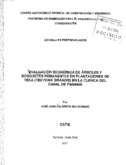Evaluación económica de árboles y bosquetes remanentes en plantaciones de teca (Tectona grandis) en la Cuenca del Canal de Panamá
Alternative title
Economic evaluation of remnant forest fragments and isolated trees in teak (Tectona grandis) plantations within the Panama Canal watershed
Description
31 ilustraciones, 20 tablas, bibliografía páginas 59-60 Tesis (Maestría)--CATIE, Turrialba (Costa Rica), 2001
Abstract
Dentro de la Cuenca del Canal de Panamá se encuentran diversas zonas, conocidas como à reas Revertidas (antiguas zonas bajo administración estadounidense) a partir de 2000, que se han concesionado para el establecimiento de plantaciones forestales comerciales. Por la regulación de política ambiental en esa estratégica región no se permite desmontar el terreno totalmente para establecer las plantaciones, por lo que dentro de las plantaciones queda vegetación remanente. Este hecho definitivamente trae consigo una serie de posibles costos y beneficios a las empresas reforestadoras. Una de las mayores concesiones fue la entregada a Ecoforest Panamá con una extensión de 7,370 hectáreas en el sector oeste de la cuenca del canal. En terrenos de esta concesión se levantó un inventario de la vegetación remanente, el cual ha sido base de la presente investigación. Se establecieron 16 sitios con vegetación remanente, sean árboles aislados o pequeños bosquetes, rodeados de árboles de teca para determinar el efecto de la sombra de la vegetación remanente sobre la teca. Los resultados demostraron que el tamaño de copa de la vegetación remanente es un fuerte indicador del efecto que causa la competencia con la teca. à rboles de teca situados alrededor de copas mayores presentaron menores medidas en altura y DAP. Se analizaron costos de 20 lotes de la plantación de teca, los cuales presentaron distintas proporciones de vegetación remanente en su superficie. Se encontró que los costos obtenidos en los lotes se deben principalmente a los gastos efectuados en trabajos relacionados con la plantación de teca y no tanto debido a la presencia de vegetación remanente. Within the Panama Canal Watershed there are several areas known as Reverted Zones (once managed by the past US administration) since 2000, which have been released through concessions for the establishment of commercial forestry plantations. Environmental policies specific to this strategic zone do not allow clear cutting for the establishment of forestry plantations, as a result forest remnants are present within plantations. The presence of these remnants have a series of benefits and costs to the reforestation companies. One of the largest concessions of 7,370 ha located on the western sector of the canal watershed was granted to Ecoforest Panamá. An inventory of the remnant vegetation was undertaken within the limits of this concession, which has been used as the basis for the present investigation. Sixteen sites with remnant vegetation (isolated trees or small forest fragments) surrounded by teak trees were established to determine the effect of the shade by the remnant vegetation on teak. The results show that crown size of the remnant vegetation is a strong indicator of the effect of competition with teak. Teak trees located around large crown sizes showed reduced height and diameter. The costs of 20 plots, which had different proportions of remnant vegetation within them, in the teak plantation were analyzed. The analyses showed that the costs obtained per plot were due to costs related to work undertaken within the teak plantation and not entirely attributable to the presence of the remnant vegetation.
Keywords
Publisher
CATIE, Turrialba (Costa Rica)
URI (Permanet link to cite or share this item)
https://repositorio.catie.ac.cr/handle/11554/4838Collections
- Tesis [3069]


